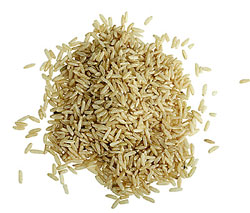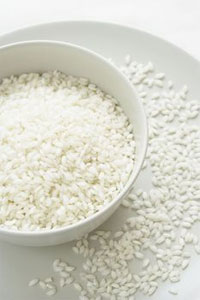Despite the overwhelming evidence of the added health benefits of fiber, vitamins and minerals of whole grains, most traditional Chinese and Ayurvedic doctors recommend eating white rather than whole brown rice. It’s generally understood that despite the superior nutrition of brown rice, white rice is the easiest to digest.
Nineteenth-century industrialism in the West brought significant advances in milling rice and flour, but even centuries before that, people had the ability to make white flour and partially polished rice. In fact, in medieval Europe white flour was preferred over brown, if for no other reason than the fact that a dishonest miller could more easily adulterate brown flour with sawdust.
Personally, I have always favored whole grains over refined. Undoubtedly this was based on the years of my being a proponent of the macrobiotic diet, featuring the 10-day brown rice diet that was advocated as a virtual panacea for all physical, mental and spiritual ills by George Ohsawa, Michio Kushi, Hermann Aihara and the late Japanese herbalist Naboro Muromoto.
Like many, I found myself conflicted with my respected teachers, Dr. Miriam Lee in traditional Chinese medicine, and Baba Hari Das in Ayurveda and yoga. Like all other traditional Chinese and Ayurvedic doctors, they mentioned repeatedly that it is not what we eat but what we are able to digest that counts and they felt that compared with brown rice, white rice was far easier to digest and assimilate.
When told how rich in nutrients brown rice was compared to white, Dr. Lee used to say, “Just add a little meat to (the white rice).” In fact, the amount of nutrients in either brown or white rice is generally low. Pellagra or beri beri, a nutritional deficiency disease seen in people who primarily depended on rice for their sustenance, rose when advanced industrial milling in the 1800s brought about an exclusive diet of white rice. The wealthy who ate white rice along with animal proteins and other foods remained unaffected from this disease, but the poor suffered and died from it.
The only traditional folk preference based on the use of brown rice I’ve heard of was shared by a former long-time Japanese shiatsu therapist, Shinzo Fujimaki who related how when growing up in a village in Japan, whenever there was any sickness in his family his mother would automatically make brown rice and miso soup.
 Digestibility Problems with Brown Rice and Other Grains
Digestibility Problems with Brown Rice and Other Grains
So what is it about rice along with other whole grains, seeds and nuts that makes them difficult to digest? They contain a number of compounds in their bran called phytins and phytic acid collectively described as antinutrient factors (ANF). This is especially true of whole wheat, which has considerably more ANF than the bran of brown rice, corn, oats or buckwheat. Apart from the tendency of the coarse bran of whole grains tending to wear down the teeth, phytins are also known to prevent the absorption of important minerals, especially calcium, magnesium, copper, iron and zinc.
Phytins in brown rice include trypsin, a pancreatic proteolitic enzyme that is needed to break down protein in grains; oryzacstatin, another protease inhibitor that interferes with the breakdown of protein in rice; and haemagglutinin, which prevents the absorption of carbohydrates through the walls of the intestines. In nature, these serve as protection from insect and animal predators, and in some instances by blocking digestive assimilation so that some of the seeds are defecated whole, able to germinate and take root elsewhere.
Some people with markedly strong digestion and metabolism may not notice any digestive problems caused by rice or other foods. However, the aging process includes a gradual cooling of metabolism leading to increased food sensitivities, allergies and other diseases that can be attributed to progressive digestive decline. Considering all of this, it’s no wonder that all traditional healing systems claim that disease begins in the stomach.
A paper published in Japan comparing the differences and effects between milled and brown rice described the following: “Digestibility and balance studies in Japanese adults on brown rice and milled rice diets at low (0.5 g/kg) and standard (1.2 g/kg) protein intakes showed a higher energy, protein and fat digestibility for milled rice (Miyoshi et al., 1986), (Table 38). Neutral detergent fibre intake was at least twice as high in the brown rice diet.”
Neutralizing the effect of phytins
The following are ways to utilize the superior nutritional benefits of whole grains while lessening or eliminating the harmful phytins.
Chewing
Michio Kushi and macrobiotics suggest chewing each mouthful of brown rice 50 times.
Pre-Soaking
The simplest method is to presoak all grains, seeds and nuts up to 24 hours, replacing the water before cooking.
Pressure Cooking
Pressure cooking can break down the indigestible elements in whole grains and legumes.
Fermenting
Herbalist Todd Caldecott, author of Food as Medicine, favors fermented rice and grains. He writes that rice in India was traditionally soaked and fermented before cooking. This seems to agree with Sally Fallon, author of Nourishing Traditions, who claims that “Our ancestors, and virtually all pre-industrialized peoples, soaked or fermented their grains before making them into porridge, breads, cakes, and casseroles.” She then cites specific dishes in India, namely idlis and dosas, as valid examples.
Todd describes a process of neutralizing most of the antinutrient factors (ANFs) by fermenting cereals and legumes to enhance their digestion and assimilation. His description is as follows: “Soak the nut, seed, grain or legume in water for 24 hours at approximately 86 degrees Fahrenheit. Set aside 10% of the soaking water after draining. Repeat this the next day with fresh ingredients, adding the reserved soaking water.” Repeat each time you make rice. The fourth round results, according to him, in a culture that can reduce ANFs such as phytic acid by 96% within 24 hours of soaking. He cautions that while the ANFs are radically reduced, other components such as lectins still require cooking for optimal digestion.
For a longer explanation, visit here.
Germinating
Hatsuga genmai is a germinated unpolished brown rice. Besides neutralizing the antinutrients in the form of phytic acid, it increases the levels of certain nutrients such as y-aminobutyric acid (GABA). The process of germination creates a softer texture than brown rice and a wonderful fragrance. It retains all the benefits of brown rice and is presently gaining in popularity in Japan as a health food. (If you’re interested in germinating at home, here is a link to a brown rice germinator you can buy.)
Partial Milling
Anyone who is an ardent fan of whole grains and brown rice but also enjoys eating sushi is likely to have had to “˜suck up’ any reservations they may have when their favorite sushi rolls are served with pasty, sticky sushi rice. I recently learned that instead of the nutritionally denuded sushi rice you can opt for a compromise and even show a bit of Japanese sophistication by asking for half milled rice called Haigamai or incompletely milled rice called Kinemai. These forms of rice have had the bran removed but not the highly nutritious germ or embryo.
The Virtues of Brown Rice
Properly prepared brown rice is one of the most biochemically-balanced foods. Its slight acidity is easily neutralized by the addition of a small pinch of salt in the cooking water. There is great therapeutic value to the 10-day brown rice fast so long as it combines legumes in the form of presoaked beans to make a more complete protein.
I have found brown rice to be the most useful food for practically every disease. It is generally antiallergenic, antihyper- and hypoglycemic, making it one of the best foods for regulating blood sugar which is one of the reasons one can feel a sense of peace and centeredness after consuming a bowl of brown rice. It also has potent anti-arthritic and anticancer properties. Because of its diuretic properties, only those who have a tendency toward frequent urination might want to determine how much and when to consume brown rice.
Rice prepared as congee (a slow-cooked watery rice porridge), alone or with the addition of vegetables, herbs or small amount of meat, is the basic therapeutic diet used by traditional Chinese doctors, and is suitable for those with weak digestion. In India a similar dish called kichari is routinely recommended by Ayurvedic doctors and in my own clinic for nearly all diseases. Like congee, kichari admits of an infinite number of variations including the addition of vegetables to form a kind of stew.
In the end, I consider the admonitions against brown rice to be appropriate for those with weak digestion or recuperating from serious illness. Presoaked or fermented brown rice, with most of the phytins neutralized is the most wholesome for regular consumption.
References:
Nourishing Traditions by Sally Fallon, pages 428 “” 430.
Genmai: Brown Rice for Better Health, Eiwan Ishida
Rice and the Ten Day Rice Diet by Lennie Richards and Al Bauman
The Book of Jook by Bob Flaws, Blue Poppy Press


Thanks, Michael. I hadn’t heard the advice to ‘just add a little meat’, and didn’t know that brown rice has a diuretic effect. Do you recommend patients with weak digestion make their congee with brown rice?
Great information and there is complete knowledge about use of Rice..
Thank you.